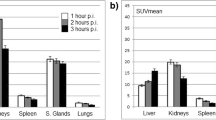Abstract
Purpose
F14512 exploiting the polyamine transport system (PTS) for tumour cell delivery has been described as a potent antitumour agent. The optimal use of this compound will require a probe to identify tumour cells expressing a highly active PTS that might be more sensitive to the treatment. The aim of this study was to design and characterize a scintigraphic probe to evaluate its uptake in cancer cells expressing the PTS.
Methods
Three polyamines coupled to a hydrazinonicotinamide (HYNIC) moiety were synthesized and labelled with 99mTc. Their radiochemical purity was determined by HPLC. The plasma stability of the 99mTc-HYNIC-spermine probe and its capacity to accumulate into PTS-active cells were also evaluated. In vitro internalization was tested using murine melanoma B16/F10 cells and human lung carcinoma A549 cells. Biodistribution was determined in healthy mice and tumour uptake was studied in B16/F10 tumour-bearing mice. A HL-60-Luc human leukaemia model was used to confront single photon emission computed tomography (SPECT) images obtained with the 99mTc-labelled probe with those obtained by bioluminescence.
Results
The 99mTc-HYNIC-spermine probe was selected for its capacity to accumulate into PTS-active cells and its stability in plasma. In vitro studies demonstrated that the probe was internalized in the cells via the PTS. In vivo measurements indicated a tumour to muscle scintigraphic ratio of 7.9±2.8. The combined bioluminescence and scintigraphic analyses with the leukaemia model demonstrated that the spermine conjugate accumulates into the tumour cells.
Conclusion
The 99mTc-HYNIC-spermine scintigraphic probe is potentially useful to characterize the PTS activity of tumours. Additional work is needed to determine if this novel conjugate may be useful to analyse the PTS status of patients with solid tumours.





Similar content being viewed by others
References
Biomarkers Definitions Working Group. Biomarkers and surrogate endpoints: preferred definitions and conceptual framework. Clin Pharmacol Ther 2001;69:89–95.
van der Meel R, Gallagher WM, Oliveira S, O’Connor AE, Schiffelers RM, Byrne AT. Recent advances in molecular imaging biomarkers in cancer: application of bench to bedside technologies. Drug Discovery Today 2010;15:102–14.
Vidal Melo MF, Winkler T, Harris RS, Musch G, Greene RE, Venegas JG. Spatial heterogeneity of lung perfusion assessed with (13)N PET as a vascular biomarker in chronic obstructive pulmonary disease. J Nucl Med 2010;51:57–65.
Larson SM, Schwartz LH. 18F-FDG PET as a candidate for “qualified biomarker”: functional assessment of treatment response in oncology. J Nucl Med 2006;47:901–3.
Schuff N, Woerner N, Boreta L, Kornfield T, Shaw LM, Trojanowski JQ, et al. MRI of hippocampal volume loss in early Alzheimer’s disease in relation to ApoE genotype and biomarkers. Brain 2009;132:1067–77.
Foster NL, Heidebrink JL, Clark CM, Jagust WJ, Arnold SE, Barbas NR, et al. FDG-PET improves accuracy in distinguishing frontotemporal dementia and Alzheimer’s disease. Brain 2007;130:2616–35.
Barret JM, Kruczynski A, Vispé S, Annereau JP, Brel V, Guminski Y, et al. F14512, a potent antitumor agent targeting topoisomerase II vectored into cancer cells via the polyamine transport system. Cancer Res 2008;68:9845–53.
Kruczynski A, Vandenberghe I, Pillon A, Pesnel S, Goetsch L, Barret JM, et al. Preclinical activity of F14512, designed to target tumors expressing an active polyamine transport system. Invest New Drugs 2011;29:9–21.
Holley JL, Mather A, Wheelhouse RT, Cullis PM, Hartley JA, Bingham JP, et al. Targeting of tumor cells and DNA by a chlorambucil-spermidine conjugate. Cancer Res 1992;52:4190–5.
Wang C, Delcros JG, Cannon L, Konate F, Carias H, Biggerstaff J, et al. Defining the molecular requirements for the selective delivery of polyamine conjugates into cells containing active polyamine transporters. J Med Chem 2003;46:5129–38.
Delcros JG, Tomasi S, Carrington S, Martin B, Renault J, Blagbrough IS, et al. Effect of spermine conjugation on the cytotoxicity and cellular transport of acridine. J Med Chem 2002;45:5098–111.
Siddiqui AQ, Merson-Davies L, Cullis PM. The synthesis of novel polyamine–nitroimidazole conjugates designed to probe the structural specificities of the polyamine uptake system in A549 lung carcinoma cells. J Chem Soc Perkin 1 1999;22:3243–52.
Seiler N, Delcros JG, Moulinoux JP. Polyamine transport in mammalian cells. An update. Int J Biochem Cell Biol 1996;28:843–61.
Guminski Y, Grousseaud M, Cugnasse S, Brel V, Annereau JP, Vispé S, et al. Synthesis of conjugated spermine derivatives with 7-nitrobenzoxadiazole (NBD), rhodamine and bodipy as new fluorescent probes for the polyamine transport system. Bioorg Med Chem Lett 2009;19:2474–7.
Annereau JP, Brel V, Dumontet C, Guminski Y, Imbert T, Broussas M, et al. A fluorescent biomarker of the polyamine transport system to select patients with AML for F14512 treatment. Leuk Res 2010;34:1383–9.
Abrams MJ, Juweid M, tenKate CI, Schwartz DA, Hauser MM, Gaul FE, et al. Technetium-99m-human polyclonal IgG radiolabeled via the hydrazino nicotinamide derivative for imaging focal sites of infection in rats. J Nucl Med 1990;31:2022–8.
Geall AJ, Blagbrough IS. Homologation of polyamines in the rapid synthesis of lipospermine conjugates and related lipoplexes. Tetrahedron 2000;56:2449–60.
Birn H, Christensen EI. Renal albumin absorption in physiology and pathology. Kidney Int 2006;69:440–9.
Surfraz MB, King RC, Mather SJ, Biagini S, Blower PJ. Technetium-binding in labelled HYNIC-peptide conjugates: role of coordinating amino acids. J Inorg Biochem 2009;103:971–7.
King RC, Surfraz MB, Biagini SC, Blower PJ, Mather SJ. How do HYNIC-conjugated peptides bind technetium? Insights from LC-MS and stability studies. Dalton Trans 2007;21:4998–5007.
Conflicts of interest
None.
Author information
Authors and Affiliations
Corresponding author
Rights and permissions
About this article
Cite this article
Pesnel, S., Guminski, Y., Pillon, A. et al. 99mTc-HYNIC-spermine for imaging polyamine transport system-positive tumours: preclinical evaluation. Eur J Nucl Med Mol Imaging 38, 1832–1841 (2011). https://doi.org/10.1007/s00259-011-1857-2
Received:
Accepted:
Published:
Issue Date:
DOI: https://doi.org/10.1007/s00259-011-1857-2




